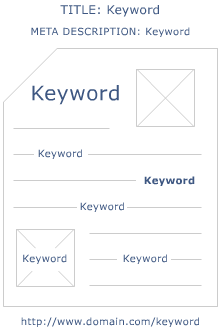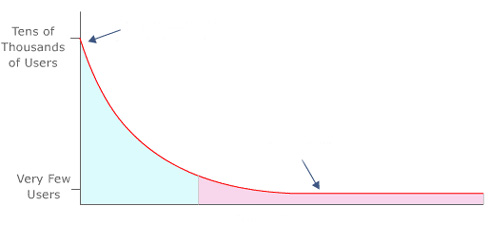Do you have a website and would like to reach a good ranking? Everybody is talking about the SEO, but even then, you are not sure what exactly needs to be done in order for your pages to be displayed on Google when searching for a particular term?
If you have questions like this, it is time to revise, understand and apply the optimization process in 6 steps!
Optimization process consists of:
Competition and market research
Research and implementation of keywords
Page optimization (on-page SEO)
Web page and internal links structure
Successful link building
Results monitoring
1. Competition and market research
The first step in finding information (and competition also) is to check search engines for information which web sites are positioned when searching words that you think are relevant for areas of interest to your site. If it is about a certain phrase that is being competed by reputable and famous web pages, you’ll have to work very hard to get results. But if for a certain keyword you get some average sites as a result (not marked as high-quality sites), then your chances are increased a lot.
How to estimate how high is a certain site ranked in the eyes of search engines? There are some factors that can help you in site value estimation:
domain age
number of backlinks
number of thematic links to the page
page popularity according to Internet users
Google PageRank
proper on-page optimization
The only thing that is left is a tool to read all this. For Firefox users there is a handy plugin that can be downloaded here. And that’s all folks! Set course to Google, Yahoo or MSN — you are ready to do some initial research!
2. Keyword research and implementation
Before you make the final decision and choose the keyword you will use for your pages, it is necessary to make a quality research and analysis of possible combinations, expressions and (often) find out some phrases that you would never expect them to be so popular. First of all, if you are targeting a highly respected and popular area of interest (lets say that your site is in english, and you are aiming at certain keyword like ‘monitors’ which is extremily popular and hard to achieve a good ranking)- in that case, the best thing to do is to pick some expression (long tail keyword) like ‘lcd screen monitors’.
Now you know that longer expressions can be very useful and effective. Next step is to put the tool into work(nothing falls from the sky, doesn’t it?)
If you have a site in english, SEObook Keyword tool could be useful because it combines results from different major search engines and can give you insight into popularity of a certain keyword, monthly searches on the basis of different languages.
In case you have a local site, Google Keyword Tool could be of use. It is a tool by which you can see the keyword popularity, competition and the number of monthly searches for a certain term. Apart from this Google tool, Wordtracker is also one of the most popular, but it is not completily free, but offers ‘free trial’ with registration.
Of course, obtained results should not be taken for granted, they should only serve you as a framework indicator of terms and expressions that are searched. Anyway, do not rely on just one tool, by combining results of several tools and with a little inspiration you can refine your keywords.
In case you already have a long-living website, make sure you have checked site statistics (Google Analytics?) and search trends, what is that your visitors look for, how the search is done, through which keywords are the visitors coming to your page…
Forums, newsgroups, blogs…they are all sources in which you can find your answers — to be more precise, you can find out what are your visitors looking for — so, offer to them what they want. It can not be more simple as it is, can it?
3. On-page optimization
SThe next step is to apply proper on-page optimization in order for search engines to better recognize, clasify, and at the end, to better rank your content when the search is made. Several months ago, a great article, more like a research was published on SEO.moz.org, in which more than 30 SEO experts stated their opinion on factors that influence the process of optimization. Since this tutorial does not go so deep into this topic, for those who would like to find out more — check this link — Search Ranking Factors v2. I will try to sum up in several guidelines:
Keywords in title tag (<title> tag)
Keywords in page content
Text and title keywords correlation
Keywords in H1 tags
Keywords in H2, H3, H4, H(x) tags
Keyword in image alt attribute (if the image content matches the keyword)
CEO of SEOmoz, Rand Fishkin, gave a simple revision:

I’ll accentuate on the fact that this revision expresses the opinion of one person and presents one way in which the optimization can be done. This is NOT some unified form that should be considered as the only way to do things. This is a matter of personal judgement, knowledge and time you are willing to spend in the process of optimization.
Also, consider it as a guideline for creating your content intended for people and not for search engines. Use heading tags (and keywords) when doing your page content distribution in order to be more clear and easier to navigate. Above all, make User friendly text, avoid keyword spamming. More on what is not reccomended in the proces of optimization can be found here: 20 SEO things you better don’t do.
4. Web page and internal links structure
If you are not sure how to distribute your page content, how ‘deep’ your page/link structure should be, maybe it would be wise of you to think hard and create several high-quality ones related to the theme you are involved in. Depending on the number of visits, reactions and other factors, you’ll expand if necessary.
Things to ensure:
Links between pages and categories.
To link every page to at least one link within site
In case you use blog tools like WordPress or Drupal, pay attention to plugins and their options on support forums/pages that are SEO friendly. It is not unusual that WordPress, for example, creates duplicate content if it is not configured properly.
5. Successful link building
Definitively, the most demanding, extensive and time consuming part of optimization process.
If the term ‘link building’ is the first time you heard of, or simply you have never worked with something like that because you didn’t know where to start, than it is time to make that first step.
Submit your link to the most popular web directories like DMOZ, Yahoo!, BOTW and Business.com (links are located below). Take into consideration that all of them, except DMOZ, are charging for link submission. Be aware that months can pass before DMOZ publishes your link (if the link passes moderation, of course).
Register your site to relevant directories related to the field of interest your site is about. There is an excellent directory article on SEObook, with review on the exquisite ones.
Make contact with the people having similar pages.
Produce alluring content, genuine and high-quality content to invite other webmasters to link it to their pages.
Register your link according to keywords within that page (for example, if your page is about cars and the keyword is ‘cars’, make sure that link you want to register to some other directory or some other page is associated with the anchor text that contains word ‘cars’. Registering the domain name as anchor text is of no use to link building strategy — except if the domain name and keyword is the same term.
Don’t always use the same anchor text when registering links, create several combinations and variations.
Prefer links from sites related to yours, because sites like that increase the link’s value due to ammount of similar contents and keywords.
Yahoo Site Explorer is a tool that will help you a lot to find quality links that lead to competition sites. You should also try to make contact and cooperate with these sites.
Link building is the basis of successful SEO campaign, and the human factor is the crucial one that makes it unpredictable, detailed and time demanding. A lot of patience, tactics and comprehension is required in order to achieve the desirable result. Remember that the success does not come over night, persistence and hard work will guarantee you a successful link building!
6. Monitoring results
After the hard work, the only thing left to do is to observe and monitor what you have done. On this link you can find Keyword Tracker Tool through which you can monitor the page position on search engines. Registration is free.
Update 20.11.2007: Keyword Tracker Tool has problems with new registrations. Google doesn’t issue keys needed for the use of this tool anymore, so if you are interested, contact me and I will give you my key.








